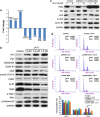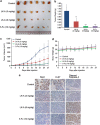Longikaurin A, a natural ent-kaurane, induces G2/M phase arrest via downregulation of Skp2 and apoptosis induction through ROS/JNK/c-Jun pathway in hepatocellular carcinoma cells
- PMID: 24651440
- PMCID: PMC3973226
- DOI: 10.1038/cddis.2014.66
Longikaurin A, a natural ent-kaurane, induces G2/M phase arrest via downregulation of Skp2 and apoptosis induction through ROS/JNK/c-Jun pathway in hepatocellular carcinoma cells
Abstract
Hepatocellular carcinoma (HCC) is the most common form of primary liver cancer, and is also highly resistant to conventional chemotherapy treatments. In this study, we report that Longikaurin A (LK-A), an ent-kaurane diterpenoid isolated from the plant Isodon ternifolius, induced cell cycle arrest and apoptosis in human HCC cell lines. LK-A also suppressed tumor growth in SMMC-7721 xenograft models, without inducing any notable major organ-related toxicity. LK-A treatment led to reduced expression of the proto-oncogene S phase kinase-associated protein 2 (Skp2) in SMMC-7721 cells. Lower Skp2 levels correlated with increased expression of p21 and p-cdc2 (Try15), and a corresponding decrease in protein levels of Cyclin B1 and cdc2. Overexpression of Skp2 significantly inhibited LK-A-induced cell cycle arrest in SMMC-7721 cells, suggesting that LK-A may target Skp2 to arrest cells at the G2/M phase. LK-A also induced reactive oxygen species (ROS) production and apoptosis in SMMC-7721 cells. LK-A induced phosphorylation of c-Jun N-terminal kinase (JNK), but not extracellular signal-regulated kinase and P38 MAP kinase. Treatment with, the JNK inhibitor SP600125 prevented LK-A-induced apoptosis in SMMC-7721 cells. Moreover, the antioxidant N-acetylcysteine prevented phosphorylation of both JNK and c-Jun. Taken together, these data indicate that LK-A induces cell cycle arrest and apoptosis in cancer cells by dampening Skp2 expression, and thereby activating the ROS/JNK/c-Jun signaling pathways. LK-A is therefore a potential lead compound for development of antitumor drugs targeting HCC.
Figures






Similar articles
-
Oridonin induces G2/M cell cycle arrest and apoptosis through MAPK and p53 signaling pathways in HepG2 cells.Oncol Rep. 2010 Sep;24(3):647-51. Oncol Rep. 2010. PMID: 20664969
-
The therapeutic effects of Longikaurin A, a natural ent-kauranoid, in esophageal squamous cell carcinoma depend on ROS accumulation and JNK/p38 MAPK activation.Toxicol Lett. 2017 Oct 5;280:106-115. doi: 10.1016/j.toxlet.2017.08.005. Epub 2017 Aug 8. Toxicol Lett. 2017. PMID: 28801140
-
Wentilactone B induces G2/M phase arrest and apoptosis via the Ras/Raf/MAPK signaling pathway in human hepatoma SMMC-7721 cells.Cell Death Dis. 2013 Jun 6;4(6):e657. doi: 10.1038/cddis.2013.182. Cell Death Dis. 2013. PMID: 23744357 Free PMC article.
-
Gadd45 in the response of hematopoietic cells to genotoxic stress.Blood Cells Mol Dis. 2007 Nov-Dec;39(3):329-35. doi: 10.1016/j.bcmd.2007.06.006. Epub 2007 Jul 30. Blood Cells Mol Dis. 2007. PMID: 17659913 Free PMC article. Review.
-
Roles of Therapeutic Bioactive Compounds in Hepatocellular Carcinoma.Oxid Med Cell Longev. 2021 Oct 31;2021:9068850. doi: 10.1155/2021/9068850. eCollection 2021. Oxid Med Cell Longev. 2021. PMID: 34754365 Free PMC article. Review.
Cited by
-
Divergent synthesis of complex diterpenes through a hybrid oxidative approach.Science. 2020 Aug 14;369(6505):799-806. doi: 10.1126/science.abb8271. Science. 2020. PMID: 32792393 Free PMC article.
-
Secalonic acid D induces cell apoptosis in both sensitive and ABCG2-overexpressing multidrug resistant cancer cells through upregulating c-Jun expression.Acta Pharm Sin B. 2019 May;9(3):516-525. doi: 10.1016/j.apsb.2018.12.006. Epub 2018 Dec 21. Acta Pharm Sin B. 2019. PMID: 31193763 Free PMC article.
-
Longikaurin A, a natural ent-kaurane, suppresses stemness in nasopharyngeal carcinoma cells.Oncol Lett. 2017 Mar;13(3):1672-1680. doi: 10.3892/ol.2017.5625. Epub 2017 Jan 19. Oncol Lett. 2017. PMID: 28454308 Free PMC article.
-
Antitumor effects of traditional Chinese medicine targeting the cellular apoptotic pathway.Drug Des Devel Ther. 2015 May 21;9:2735-44. doi: 10.2147/DDDT.S80902. eCollection 2015. Drug Des Devel Ther. 2015. PMID: 26056434 Free PMC article. Review.
-
Piperlongumine selectively kills hepatocellular carcinoma cells and preferentially inhibits their invasion via ROS-ER-MAPKs-CHOP.Oncotarget. 2015 Mar 20;6(8):6406-21. doi: 10.18632/oncotarget.3444. Oncotarget. 2015. PMID: 25788268 Free PMC article.
References
-
- Gamet-Payrastre L, Li P, Lumeau S, Cassar G, Dupont MA, Chevolleau S, et al. Sulforaphane, a naturally occurring isothiocyanate, induces cell cycle arrest and apoptosis in HT29 human colon cancer cells. Cancer Res. 2000;60:1426–1433. - PubMed
-
- Wei Z, Jiang X, Qiao H, Zhai B, Zhang L, Zhang Q, et al. STAT3 interacts with Skp2/p27/p21 pathway to regulate the motility and invasion of gastric cancer cells. Cell Signal. 2013;25:931–938. - PubMed
Publication types
MeSH terms
Substances
LinkOut - more resources
Full Text Sources
Other Literature Sources
Medical
Research Materials
Miscellaneous

